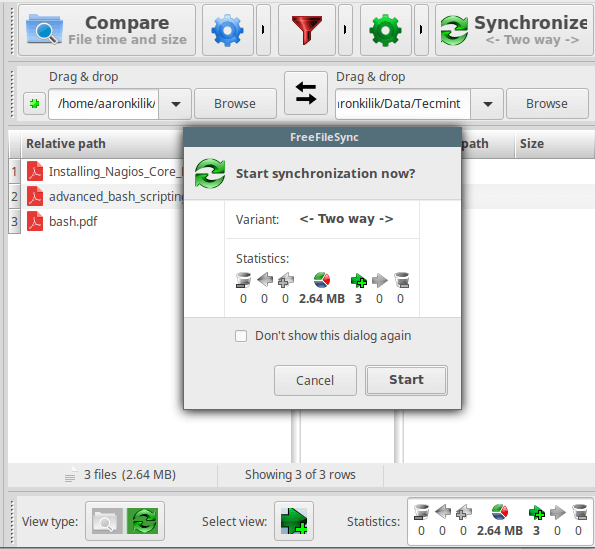

- #FILE SYNCHRONIZATION UBUNTU APK#
- #FILE SYNCHRONIZATION UBUNTU INSTALL#
- #FILE SYNCHRONIZATION UBUNTU UPDATE#
- #FILE SYNCHRONIZATION UBUNTU ARCHIVE#
- #FILE SYNCHRONIZATION UBUNTU WINDOWS#
Will be reported as conflicts, and any files that exist only on one This means that any files that are different Unison will assume that the 'last synchronized state' of both replicas
#FILE SYNCHRONIZATION UBUNTU UPDATE#
Update detection may take a while on this run if the replicas are Or because you have upgraded Unison to a new version with a different
#FILE SYNCHRONIZATION UBUNTU ARCHIVE#
Warning: No archive files were found for these roots, whose canonical names are:īecause this is the first time you have synchronized these roots, Finally, press y and hit ENTER key to proceed with propagating updates. Press ENTER or press f key to confirm the files and folders that you want to synchronize. Next, Unison will ask you to confirm the files and directories to synchronize. You will be prompted if you want to continue to sync the contents of directory1 with directory2. Let us sync these two directories using unison with command: $ unison directory1/ directory2/ Inside the dir1, there is another file called file3.Īnd the directory2 replica doesn't have any contents. rw-rw-r- 1 sk sk 141729 Aug 6 22:34 file3Īs you can see, I have a folder called dir1 and two other files namely file1 and file2 in the root of directory1. Let us take a look at the contents of directory1: $ ls -ltRF directory1/ĭrwxrwxr-x 2 sk sk 4096 Oct 2 15:35 dir1/ I stored some files and directories inside directory1. Put some contents on any one of the above directories. $ mkdir ~/directory1 $ mkdir ~/directory2 replicas) namely directory1 and directory2. Sync files stored in different directories on the same machineįor the purpose this guide, I am going to create two root directories (i.e.


Sync files stored in different directories on the same machine,.We can use Unison in the following three different modes: Also, the same version on both systems is recommended.
#FILE SYNCHRONIZATION UBUNTU INSTALL#
Please note that if you want to synchronize files between two different systems, you must install Unison on all systems that you want to keep in sync. If you are on a Debian-based system, install it using the following command: $ sudo apt install unison-gtk On Arch Linux and its variants, install Unison-gtk using command: $ sudo pacman -S unison-gtk2
#FILE SYNCHRONIZATION UBUNTU APK#
On Alpine Linux, you can install Unison-gtk using command: $ sudo apk add unison-gui It is available in the default repositories in a few Linux distributions. There is also simple graphical interface named unison-gtk is available for those who prefer GUI over CLI. Install Unison on Arch Linux and its variants like EndeavourOS and Manjaro Linux: $ sudo pacman -S unisonĭebian, Ubuntu, Linux Mint: $ sudo apt install unisonįirst, enable repository: $ sudo yum install epel-releaseĪnd then install unison: $ sudo yum install unison To install Unison on Alpine Linux, run: $ sudo apk add unison Unison is available in the default repositories in the official repositories of many Linux operating systems.
#FILE SYNCHRONIZATION UBUNTU WINDOWS#
It works under GNU/Linux, Windows and Unix platforms. Pierce and is released under GPL license. The Unison program is created by Benjamin C. Unison is a user-level program, so there is no need to modify the kernel or to have superuser privileges on either host. Unison's built-in implementation of the rsync algorithm makes transferring updates to existing files very fast. The files are synchronized to a remote system via an encrypted ssh connection.Īnother notable feature of Unison is it works well over slow links such as PPP connections. Similar to rsync, Unison will only transfer the parts of a file that have been changed. Unison works well with any pair of computers connected to a local area network or Internet. Updates that do not conflict will be propagated automatically. In that case, you need to instruct Unison which replica should override the other. Unison will detect and display such conflicts. If the content are different on both replicas, it causes a conflict. Not just file content, even the file ownership and permissions will also be sychronized. Since it is a multi-platform application, you can synchronize files and directories between computers that runs with different operating systems.įor instance, you can synchronize files stored in a Linux machine with a Windows or Unix machines and vice versa. To put this in simple terms, any changes in the one location will be replicated to other location and vice versa. The replicas of files and directories are modified separately and then brought up-to-date by propagating the changes in each replica to the other.


 0 kommentar(er)
0 kommentar(er)
